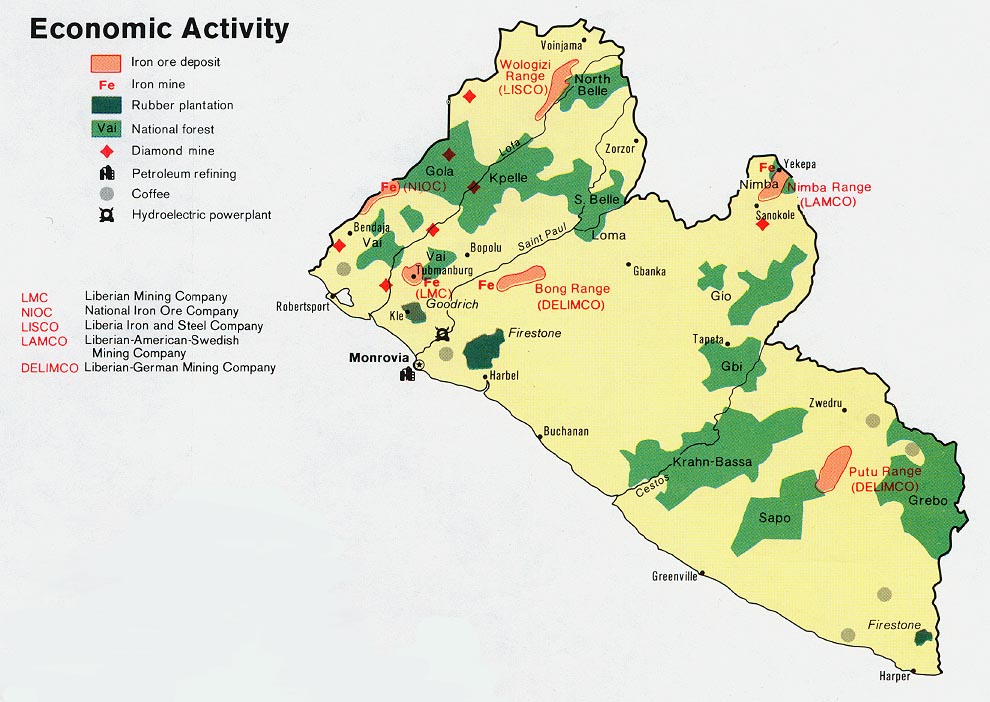Liberia is a land rich in natural resources including:
- Iron ore
- Gold
- Diamonds
- Timber
- Rubber
As of 2014, Liberia had:
- At least 52 mining companies, 49 of which are wholly foreign-owned
- At least 18 forestry companies, most of which are also foreign-owned
- 4 privately owned oil companies (all foreign-owned: European Hydrocarbons, Anadarko Liberia, Chevron Liberia, and Exxon Mobil) and 1 state-owned oil company (NOCAL - National Oil Company of Liberia) [1]
Discovery of Oil
In 2012, potentially large deposits of oil were discovered off the coast of Liberia. However, the exploration stage and process towards production can last many years. [2] Although there is currently no oil production in Liberia, the country has awarded exploration licenses, and the money from those signature bonuses have contributed nearly 10% of the total government revenues. [3] |
| Source: http://www.lib.utexas.edu/maps/africa/liberia_econ_1973.jpg |
Iron Ore Mining
Prior to 1990, mining had represented 65% of export earnings and 25% of Liberia's GDP. However, when civil war ravaged the country for the 14 years between 1989 and 2003, all major mines were closed. [4] As of 2013, the mining sector had rebounded, representing 17% of the GDP and 56% of the worth of exports. [5]
Gold
Gold production in Liberia during the war years was at an all-time high. From 1991 to 2002, it never fell below 500 kilograms, with the exception of 1994, when there was no reported gold production. Most years during that time saw levels between 700-1000 kilograms per year. Then, coinciding with the end of the civil war, there was a dramatic drop to between 10 and 110 kilograms between the years 2002 and 2006. 2007 saw a substantial recovery, to over 300 kilograms, and from 2008 until 2012 production averaged between 450 kilograms and 665 kilograms per year. [6]
More recently, a new commercial gold mine has been opened by the Aureus Mining company. During the month of February 2016 alone, the output was estimated at 255 kilograms (9,000 ounces). [7]
Illegal gold mining, diamond mining, and trade in timber is a serious problem in Liberia which the government is unable to control. The rogue miners dig without safety precautions, and there can be violence over territory. The illicit gold, for example, is then smuggled out of the country and sold to Middle Eastern markets such as Dubai. [8]
Unfortunately, Liberia's natural resources, such as diamonds and timber, were being used to fuel its bloody civil war. As a result, these diamonds were given the name "conflict diamonds" or "blood diamonds". The UN banned importing Liberian diamonds and timber from 2001 and 2003 respectively [9] until mid-2007. [10]
In the meantime, an international certification program was designed to prevent "conflict diamonds" from being traded, called the Kimberley Process. Since 2007, the following figures represent Liberia's diamond production based on the Kimberley Process: [11]
Year Carots Value (USD)
2015 68,575.73 $31,459,636.07
2014 65,822.49 $28,175,134.04
2013 53,699.16 $19,680,742.14
2012 41,985.13 $16,164,275.05
2011 41,932.19 $16,183,202.46
2010 26,590.89 $15,954,534.00
2009 28,368.27 $11,260,572.94
2008 47,006.50 $ 9,891,785.34
2007 21,699.74 $ 2,657,541.58
In recent years, a plant has been discovered in Liberia that may be a good indicator of the location of diamonds. The palm-like plant, called Pandanus candelabrum seems to only grow on top of kimberlite pipes, which bring diamonds to the surface from their birthplace hundreds of kilometers inside the earth. [12]
Pandanus candelabrum - Diamond-loving plant in Liberia

By Marco Schmidt - Own work (own foto), CC BY-SA 2.5, https://commons.wikimedia.org/w/index.php?curid=788015
Timber and Rubber
Aside from mining, the other two major natural resources in Liberia are timber and rubber. Liberia is home to 43% of the Upper Guinea rain forest, so timber plays an important role in the economy, while rubber is the most important cash crop in the country. [13] During the civil war, the sale of timber was used to finance the war, and as such was subject to UN restrictions as well.
Works Cited:
[1] LEITI Beneficial Ownership Final Report December 2015, accessed July 27, 2016, http://www.leiti.org.lr/uploads/2/1/5/6/21569928/leiti_beneficial_ownership_final_report__december__2015.pdf.
[2] John Daly, "Liberia Announces Major Offshore Oil Find," Oilprice.com, February 24, 2012, accessed July 27, 2016, http://oilprice.com/Latest-Energy-News/World-News/Liberia-Announces-Major-Offshore-Oil-Find.html.
Works Cited:
[1] LEITI Beneficial Ownership Final Report December 2015, accessed July 27, 2016, http://www.leiti.org.lr/uploads/2/1/5/6/21569928/leiti_beneficial_ownership_final_report__december__2015.pdf.
[2] John Daly, "Liberia Announces Major Offshore Oil Find," Oilprice.com, February 24, 2012, accessed July 27, 2016, http://oilprice.com/Latest-Energy-News/World-News/Liberia-Announces-Major-Offshore-Oil-Find.html.
[3] "Liberia," Extractive Industries Transparancy Initiative, accessed July 27, 2016, https://eiti.org/Liberia.
[4] Ibid.
[4] Ibid.
[5] "Military: Liberian Economy," GlobalSecurity.org, last updated September 17, 2014, accessed July 28, 2016, http://www.globalsecurity.org/military/world/liberia/economy.htm.
[6] "Liberia: history of gold production," 24hgold.com, accessed July 27, 2016, http://www.24hgold.com/english/stat_country_detail.aspx?pays=Liberia&deid=24470B1670.
[7] "Aureus declares commercial production at New Liberty gold mine in Liberia," Mining-technology.com, March 4, 2016, accessed July 27, 2016, http://www.mining-technology.com/news/newsaureus-declares-commercial-production-new-liberty-gold-mine-liberia-4829952
[8] African Network of Centres of Investigative Journalism, "Special report: Illegal gold mining in Liberia," Daily Maverick, February 5, 2015, accessed July 27, 2016, http://www.dailymaverick.co.za/article/2015-02-05-special-report-illegal-gold-mining-in-liberia#.V5l28PkrLIU.
[9] "Liberia," Global Policy Forum of the United Nations, accessed July 27, 2016, https://www.globalpolicy.org/security-council/index-of-countries-on-the-security-council-agenda/liberia.html.
[10] Warren Hoge, "Liberia: Diamond Ban Lifted," The New York Times, April 28, 2007, accessed July 27, 2016, http://www.nytimes.com/2007/04/28/world/africa/28briefs-diamond.html?_r=0.
[11] "Liberia," Kimberley Process, accessed July 27, 2016, https://www.kimberleyprocess.com/en/liberia.
[12] Eric Hand, "Rare African plant signals diamonds beneath the soil," Science Magazine, May 4, 2015, accessed July 27, 2016, http://www.sciencemag.org/news/2015/05/rare-african-plant-signals-diamonds-beneath-soil.
[13] Asamoah Larbi, "Country Pasture/Forage Resource Profiles: Liberia," Food and Agriculture Organization of the United Nations, last revised July 2012, accessed July 28, 2016, http://www.fao.org/ag/AGP/AGPC/doc/Counprof/Liberia/liberia.htm.


